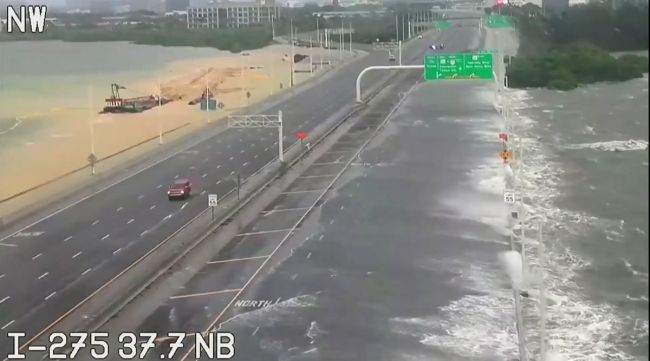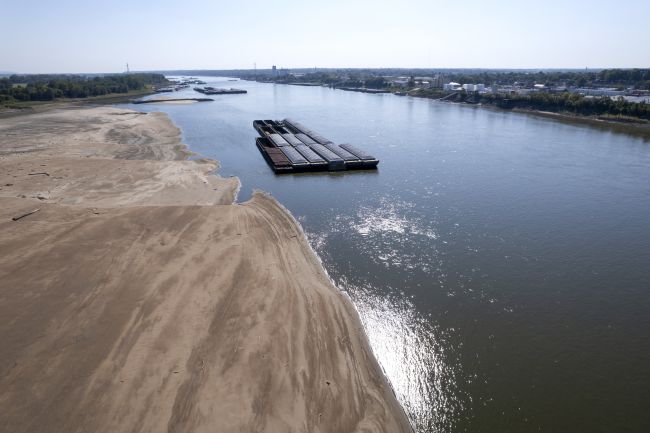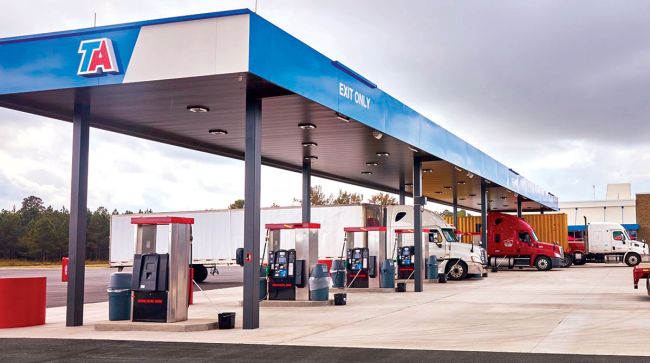CEDAR KEY, Fla. — Hurricane Idalia made landfall Aug. 30 in Florida as a Category 3 storm and unleashed devastation along a wide stretch of the Gulf Coast, submerging homes and vehicles, turning streets into rivers, unmooring small boats and downing power lines in an area that has never before received such a pummeling.
More than 263,000 customers were without electricity as rushing water covered streets near the coast. As the eye moved inland, destructive winds shredded signs, sent sheet metal flying and snapped tall trees. Downed power lines closed northbound Interstate 75 just south of Valdosta, Ga. The system was downgraded to a tropical storm in late afternoon Aug. 30.
“We have multiple trees down, debris in the roads, do not come,” posted the fire and rescue department in Cedar Key, where a tide gauge measured the storm surge at 6.8 feet, submerging most of the downtown. “We have propane tanks blowing up all over the island.”
Idalia came ashore in the lightly populated Big Bend region, where the Florida Panhandle curves into the peninsula. It made landfall near Keaton Beach at 7:45 a.m. EDT as a high-end Category 3 hurricane with maximum sustained winds near 125 mph.
Look at this gas station… wow. Just shows how powerful Hurricane Idalia was when coming through the town of Perry Florida @fox35orlandopic.twitter.com/fhVVHlTnmg
— Deborah Choe (@DeborahChoeTV) August 30, 2023
It remained a hurricane as it crossed into Georgia, with top winds of 90 mph at 11 a.m., after drenching Florida mostly to the east of Tallahassee. The storm brought strong winds to Savannah, Ga., in the evening as it made its way toward the Carolinas. It was forecast to move near or along the coast of South Carolina through the night and then just off the coast of North Carolina on Aug. 31 before heading out into the Atlantic Ocean.

Members of the Tampa Fire Rescue Department remove a downed street pole after large awnings from an apartment building blew off and hit it from winds associated with Hurricane Idalia on Aug. 30 in Tampa, Fla. (Associated Press/Chris O’Meara)
In response to the storm, Florida Gov. Ron DeSantis issued two emergency waivers for commercial motor vehicles and certain hours-of-service requirements and size/weight restrictions were lifted. Georgia, Kentucky, North Carolina and South Carolina posted similar waiver orders Aug. 29.
Florida Executive Order 23-171, which expires Oct. 25, contains numerous exemptions related to emergency relief. It temporarily suspends enforcement of registration requirements for commercial motor vehicles entering Florida to provide emergency services/supplies, transport emergency equipment, supplies or personnel or bring Federal Emergency Management Administration mobile homes/office-style mobile homes in or out of the state.
DO NOT TRY TO TRAVEL I-10 AROUND TALLAHASSEE: just got a call from the FLHSMV spokesperson. She sent me this video and says there are lots of downed trees
Blocking I-10 and many motorist stranded. Please stay off the interstate.
-EB 241-252 only one lane
-WB Exits 233-258 @WCTVpic.twitter.com/QrJ26yrdTq— Katie Kaplan (@KatieKaplanTV) August 30, 2023
It waives hours-of-service requirements and size/weight restrictions for divisible loads on any vehicles transporting emergency equipment, services, supplies and agricultural commodities (such as citrus fruit) recommended by the state agriculture commissioner. It also allows state officials to create alternate size and weight restrictions for all such vehicles during the emergency.

Transport Topics’ Seth Clevenger, Michael Freeze and Mike Senatore dissect the new Top 100 list of the largest private carriers, including how fleets are adapting to this softened market. Tune in above or by going to RoadSigns.ttnews.com.
Tolls were waived on highways in the danger area and shelters were opened. More than 30,000 utility workers were gathering to make repairs as quickly as possible in the hurricane’s wake. About 5,500 National Guard troops were activated.
Both Georgia Gov. Brian Kemp and South Carolina Gov. Henry McMaster announced states of emergency, freeing up state resources and personnel, including hundreds of National Guard troops.
Astounded by the flooding that turned Tampa’s Bayshore Boulevard into a river, Bill Hall watched a paddleboarder ride along the major thoroughfare.
“This is actually unbelievable,” Hall said. “I haven’t seen anything like this in years.”

Floodwaters pushed by Hurricane Idalia pour over the sea wall along Old Tampa Bay as paddleboarder Zeke Pierce goes for a ride Aug. 30. (Associated Press/Chris O’Meara)
In Tallahassee, Florida’s capital city, the power went out well before the center of the storm arrived.
Tallahassee Mayor John Dailey urged everyone to shelter in place — it was too late to risk going outside. Florida residents living in vulnerable coastal areas had been ordered to pack up and leave as Idalia gained strength in the warm waters of the Gulf of Mexico.
“Don’t put your life at risk by doing anything dumb at this point,” Gov. Ron DeSantis said at a news conference the morning of Aug. 30. “This thing’s powerful. If you’re inside, just hunker down until it gets past you.”
Storm surge was expected to rise as high as 16 feet in some places. Some counties implemented curfews to keep residents off roads.
“For those who have chosen to remain on the beaches despite the mandatory evacuation order, please restrict your water and toilet usage,” the city of Clearwater posted. “Due to flooding, the city’s lift stations and stormwater system are under strain.”
Diane Flowers was sound asleep at 1 a.m. Aug. 30 in her Wakulla County home, but her husband was up watching the weather on TV, and he got a text from their son when the storm was upgraded to a Category 4. He’s a firefighter/EMT in Franklin County, which is also along the Gulf Coast.
“He said, ‘You guys need to leave,’ ” Flowers said. “And he’s not one for overreacting, so when he told us to leave, we just packed our stuff, got in our car and got going.”
They quickly packed a few clothes, medicine, dog food for their two border collies, a computer, important documents and a bag of Cheetos. Motels were packed all the way into Alabama, where they ended up finding a room in Dothan. Idalia weakened to a high-end Category 3 storm before making landfall.
The National Weather Service in Tallahassee called Idalia “an unprecedented event” since no major hurricanes on record have ever passed through the bay abutting the Big Bend. The state, still dealing with lingering damage from last year’s Hurricane Ian, feared disastrous results.
Not everyone heeded the warnings to leave, and Hernando County Sheriff Al Nienhuis said the county couldn’t guarantee rescues for people who didn’t evacuate, since coastal roads would only get more flooded as high tide pushes more water inland.
“It’s going to do nothing but go up from here,” said Nienhuis, whose county is north of the Tampa area.
As the winds began to lash coastal Georgia, customers where still visiting Mary Hennig’s bait and tackle shop on St. Simons Island for snacks and coffee.
“Hurricanes here haven’t been what they keep saying they’re going to be,” Hennig said. “So people aren’t going to take it as seriously.”





